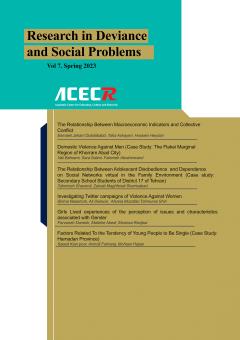The Relationship Between Macroeconomic Indicators and Collective Conflict
Subject Areas : Violence
Ismail Jahani Dolatabad
1
![]() ,
taha ashayeri
2
,
taha ashayeri
2
![]() ,
Hossein Heydari
3
,
Hossein Heydari
3
![]()
1 - Associate Professor, Department of History and Sociology, Faculty of Social Science, University of Mohaghegh Ardabili, Ardabil, Iran.
2 - Assistant Professor, Department of History and Sociology, Faculty of Social Science, University of Mohaghegh Ardabili, Ardabil, Iran.
3 - Assistant Professor, Insitute for Humanities and Social Studies in ACECR, Tehran. Iran
Keywords: Collective Conflict, Relative Deprivation, Economic Anomie, Economic Disorganization, Secondary Analysis. ,
Abstract :
Collective conflict refers to the conflict, conflict and physical tension of more than two people, which is affected by the social, economic and cultural conditions of the society. According to surveys, and based on the data of the Forensic Medicine Organization since 2013 to 2121, the amount of conflict has increased in the provinces of the country. The main purpose of the research is to study of the relationship between macroeconomic indicators and collective conflict in the period of 2015-2018. The research method is the secondary analysis, data were analyzed using Spss software. The results are reported in the form of descriptive, including frequency tables, and charts, and central indices, as well as inferential statistics, including bivariate and multivariate tests. The results show that the increase in inflation, unemployment and Gini coefficient between 2015 and 2018 has been effective in increasing the amount of conflict in different provinces of the country. According to this, with economic disorder (economic disorganization), due to the increase in unemployment, inflation and class gap as well as the reduction of social resilience, mental instability, the feeling of scarcity of resources (crisis of production, distribution and consumption) and the feeling of economic abnormality, people's social behaviors has become more radical, violent and aggressive. The important reason for the collective conflict in the provinces of the country in the above period of time has been functioning of economic institutions.
دورکیم، امیل (1398) درباره تقسیم کار اجتماعی، ترجمه باقر پرهام، تهران، مرکز.
شاطریان، محسن و دیگران (1393) «عوامل اجتماعی- فرهنگی مؤثر بر گرایش به نزاع طایفهای (مورد مطالعه: عشایر ایل پیجیک، شهرستان اهر)»، فصلنامه توسعه اجتماعی (توسعه انسانی سابق) سال نهم، شماره 2، صص 7-36.
صادقی، حسین و دیگران (1384) «تحلیل عوامل اقتصادی اثرگذار بر جرم در ایران»، فصلنامه تحقیقات اقتصادی، شماره 62، صص 63-90.
عزیزمحمدلو، حمید (1399) «تحلیل ارتباط صنعتی شدن، تقسیم کار اجتماعی و روابط اجتماعی در ایران مبتنی بر دیدگاه دورکیم با رویکرد اقتصادسنجی فضایی»، دوفصلنامه جامعهشناسی اقتصادی و توسعه، سال نهم، شماره 1، صص 191-217.
عشایری، طاها و دیگران (1401) «مرور نظاممند مسائل اجتماعی ایران و الگوهای پیشگیری آن، بازه زمانی 1380 الی 1400»، مجله جامعهشناسی ایران، سال بیست¬ودوم، شماره 3، صص120-152.
عمید، حسن (1390) فرهنگ عمید، تهران، امیرکبیر.
فرخ سیدی، منصور (1380) فرهنگ اصطلاحات کیفری، تهران، زر.
معین، محمد (1387) فرهنگ فارسی، تهران، فرهنگ¬ نما با همکاری کتاب آراد.
مهرگان، نادر و سعید گرشاسبی فخر (1390) «نابرابری درآمد و جرم در ایران»، پژوهشهای رشد و توسعه پایدار (پژوهشهای اقتصادی)، دوره یازدهم، شماره 4، صص 109- 125.
نوغانی دخت بهمنی، محسن و سید احمد میرمحمدتبار (1394) «بررسی عوامل اقتصادی مؤثر بر جرم، فراتحلیلی از تحقیقات انجام-شده در ایران»، پژوهشهای راهبردی امنیت و نظم اجتماعی، سال چهارم، شماره 3، صص 85- 102.
Aloosh, M.; Salavati, A. & Aloosh, A. (2016) Economic Sanctions threaten Population Health, the Case of Iran, public health, Volume 169, 10-13.
Boudreaux, K. & Abrahams, D. (2022) Land and Conflict, A Toolkit for Intervention, United States Government. Brauman, B. (2000) “Real Effects of High Inflation, IMF Working Paper, 00/85 (Washington, International Monetary Fund).
Buonanno, P. & Vargas, J. F. (2019) Inequality, Crime, and the long Run Legacy of Slavery. Journal of Economic Behavior & Organization, 159, 539-552.
Feindouno, S. & Wagner, L. (2016) The Determinants of Internal Conflict in the World, How To Estimate the Risks and Better Target Prevention Efforts? 63 Boulevard François Mitterrand- CS 5032063009 Clermont-Ferrand Cedex (France), www. ferdi.
Gilens, M. & Page, B. I. (2014) Testing Theories of American Politics, Elites, Interest Groups, and Average Citizens. Perspectives on Politics, 12(3), 564-581.
Groot,O. ; Alamir, A. ; Bozzoli, C. & Bru¨ck, T. (2022) The global economic burden of violent conflict, Journal of Peace Research, 59 (2) 259–276.
Keseljevic, A. (2007) Indexes of economic freedom- An outline and open issues, Zb. rad. Ekon. fak. Rij. 25 (2), 223-243.
McGuirk, E. & Burke, M. (2017) NBER WORKING PAPER SERIES, the economic origins of conflict in Africa, Working Paper 23056, national bueeau of economic research, Massachusetts Avenue, Cambridge, MA. Merton, R. K. (1938) “Social Structure and Anomie, American Sociological Review 3(5), 672-682.
Mishko, D.; Mirakovski, D.; Simeonov, S.; Cvetkov, S. & Sovreski, Z. (2013) Relationship between Economic Freedom and Conflict in the Balkan Region, International Journal of Scientific & Engineering Research, 4 (10), 433-436.
Orru, M. (1983) "The Ethics of Anomie, Jean Marie Guyau and Émile Durkheim. " British Journal of Sociology, 34(4), 499–518.
Rose, S. (2015). Applying Durkheim’s Theory of Suicide, A Study of Altruism and Anomie among Canadian Veterans of Afghanistan. Kingston, Ontario, Queen’s University. p. 49.
Sidaway, R. (2005) Resolving Environmental Disputes. From Conflict to Consensus, Taylor and Francis, London.
Staines, N. (2004) Economic Performance Over the Conflict Cycle, IMF Working Paper,Policy Development and Review Department.
Vega, M. & lvarez, L. A. (2003) Economic Growth and Freedom, A Causality Study, Cato Journal, 23 (2), 199-215.


